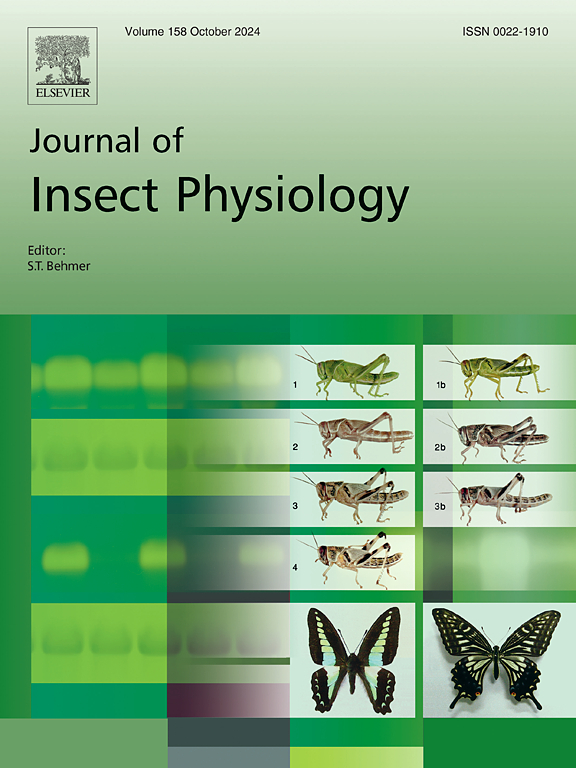Plastic responses in sperm expenditure to sperm competition risk in black soldier fly (Hermetia illucens, Diptera) males
IF 2.3
2区 农林科学
Q1 ENTOMOLOGY
引用次数: 0
Abstract
In polyandrous species, competition between males for offspring paternity goes on after copulation through the competition of their ejaculates for the fertilisation of the female’s oocytes. Given that males allocating more spermatozoa often have greater fertilisation success, different models of sperm competition predict adaptive plasticity in male sperm production and allocation. These predictions were tested experimentally in the black soldier fly (BSF) Hermetia illucens. In this farmed insect, adult biology is little known despite the economic interest of larvae for bioconversion, and as authorized feedstuff. In lab conditions, two sets of experiments were carried out to modify the risk of sperm competition perceived by males. The first consisted of placing adult males alone or in groups of 10 – modifying the mean risk of sperm competition – and then measuring their sperm production. The second took place at the beginning of copulation; pairs with males from the two treatments were transferred to different contexts of immediate risk of sperm competition: empty cages, cages containing 10 males, or cages containing 10 females. In all cases, spermatozoa transferred to mated females were counted. Males reared in groups of 10 showed more spermatozoa in their seminal vesicles than males reared alone. Regarding sperm allocation, females that mated in the presence of conspecifics – either 10 males or 10 females – received more spermatozoa than those that mated in isolation. In BSF, sperm production and allocation are influenced by the risk of sperm competition, demonstrating reproductive plasticity in response to socio-sexual conditions.

雄性黑兵蝇(Hermetia illucens,双翅目)精子消耗对精子竞争风险的可塑性反应
在一妻多夫制的物种中,雄性之间为了后代的父权而进行的竞争在交配后通过射精争夺雌性卵母细胞的受精。考虑到分配更多精子的男性通常有更大的受精成功率,不同的精子竞争模型预测了男性精子产生和分配的适应性可塑性。这些预测在黑兵蝇(BSF) Hermetia illucens身上进行了实验验证。在这种养殖昆虫中,尽管幼虫具有生物转化的经济利益,并作为批准的饲料,但对成虫生物学知之甚少。在实验室条件下,进行了两组实验来改变男性感知到的精子竞争风险。第一个实验是将成年雄性单独或10只一组——修改精子竞争的平均风险——然后测量它们的精子产量。第二次发生在交配开始的时候;来自两种处理的雄鼠被转移到不同的有精子竞争直接风险的环境中:空笼子,含有10只雄鼠的笼子,或含有10只雌鼠的笼子。在所有情况下,转移给交配雌性的精子都被计数。与单独饲养的雄性相比,10只一组饲养的雄性在精囊中显示出更多的精子。在精子分配方面,在同种生物存在的情况下交配的雌性——无论是10只雄性还是10只雌性——比单独交配的雌性获得更多的精子。在BSF中,精子的产生和分配受到精子竞争风险的影响,表明生殖可塑性是对社会性别条件的反应。
本文章由计算机程序翻译,如有差异,请以英文原文为准。
求助全文
约1分钟内获得全文
求助全文
来源期刊

Journal of insect physiology
生物-昆虫学
CiteScore
4.50
自引率
4.50%
发文量
77
审稿时长
57 days
期刊介绍:
All aspects of insect physiology are published in this journal which will also accept papers on the physiology of other arthropods, if the referees consider the work to be of general interest. The coverage includes endocrinology (in relation to moulting, reproduction and metabolism), pheromones, neurobiology (cellular, integrative and developmental), physiological pharmacology, nutrition (food selection, digestion and absorption), homeostasis, excretion, reproduction and behaviour. Papers covering functional genomics and molecular approaches to physiological problems will also be included. Communications on structure and applied entomology can be published if the subject matter has an explicit bearing on the physiology of arthropods. Review articles and novel method papers are also welcomed.
 求助内容:
求助内容: 应助结果提醒方式:
应助结果提醒方式:


